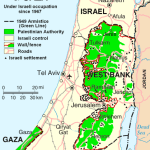Following is part of a series of essays from my press tour to Jordan, sponsored by the Jordan Tourism Board and Phillips Theological Seminary.
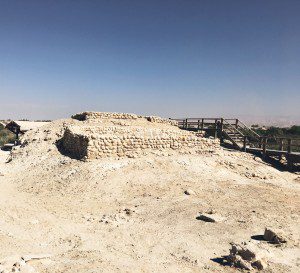
As we neared the Jordan River, we came across Elijah’s Hill, the site where many believe the prophet ascended to heaven. Such ascension stories are found in many of the world’s religions, including Islam. The Prophet Muhammad himself (peace be upon him) was said to have ascended in similar fashion, as did Jesus. It symbolizes transcendence, escape, freedom from the bondage of earthly existence and the trials of the physical world that bind us.
The site itself, like so many we visited, was so much smaller than I ever imagined. While I would imagine
a dramatic mountainside from which the great prophet was swept up into God’s embrace, this was a small mound, no higher than fifty feet up from the surrounding land. Had it not been pointed out as a site of significance, it would have been effectively invisible, inconsequential. But now, it meant something. It was the lynchpin to a greater story, one with which we connected. It was familiar, while also curiously foreign.
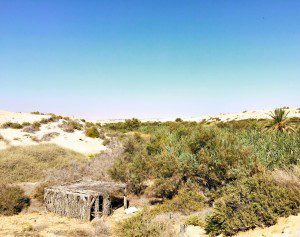
From there, we were led through the brush to a cistern, fashioned out of local rocks, hewn from the cliff sides. In the center of the cruciform intersection stood no more than eight inches of water, marking the stones along its perimeter with what looked a lot like oxidized copper. This, asserted our guide, was the place where John the Baptist blessed Jesus in the waters of baptism, setting off the beginning of his years in active ministry. It was simple, small, shallow, only noticeable because of the human-made monument to its importance, now containing the ankle-deep tributary.
This is it? Doesn’t it glow or spring up in a geyser on the hour? Don’t the angels join in a daily chorus to announce the sacredness of the site?
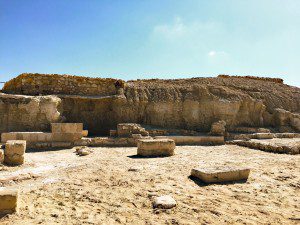
Instead it was understated, simple, left to mean what it needs to mean to those who discover it, much like the bulk of Jesus’ gospel messages themselves. What do they mean? What do we take away from them? That, ultimately, is between us as individuals, God, and no one else.
The site itself is, much like so much of the surrounding territory, hotly contested. Only recently (in a greater historic sense) was the area cleared of all remaining land mines. The buoys that marked the Israeli-Jordanian border, cutting down the middle of the river’s main artery, were just yards off. The guard towers on the Israeli bank were visible from a clearing where we stood. And even this, a place of such holy significance, became the subject of territorial conflict, as the Israelis contend that the true baptism site was located on their side.
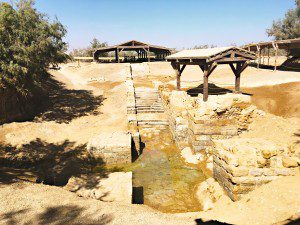
Why does this matter? Why are we so hungry for particular, somehow eternal, sacred space? What is our fascination with holy places and grasping at a sense that somehow God’s hand passed directly over this place? And is it the actual place that matters more, or the importance we lend it? That depends on who you ask, of course, as varying religious disciplines have different assertions about the geography of the sacred. After all, our need for delineations and claims on spaces leads to so much human-borne conflict, even violence. Doesn’t this stand in opposition to what the sacred spaces stand for? Aren’t we contaminating them simply in staking our claim?
The associate director of the site graciously invited our group to take a sample of the baptismal waters home with us, a privilege (at least according to him) generally only afforded to pontiffs. As I dipped by bottle into the shallow creek, I wondered how many times that particular water had passed through this place. Certainly it bore no connection to the actual water washing over Jesus’ head at the moment of his baptism? But what if it did? What if I contained some traces of the waters in my own body, unknown to me? Would it mater? What makes it holy?
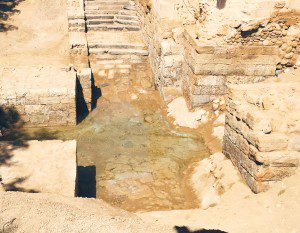
One of our colleagues, Rosalind Hughes, summed these questions that are at the root of such pursuits, conflicts and arguments about the significance of place. Her four words broke the issue open in a beautiful way: ALL WATER IS HOLY.
None is more or less significant than the rest. Its very existence bears the fingerprint of creation itself, the breath of life that animates all being. To debate or fight about the importance of this spot over that one is akin to quibbling about who will sit at the right hand of God versus the left. It just doesn’t matter that much.
The stories we tell, and the meaning we give them, are what matter. The intent behind them to reach across and bridge the impossible gap between humanity and the Divine. The desire to finally close the space between the fingers of Adam and God, as depicted on the ceiling of the Sistine Chapel in Vatican, both sides longing for connection, yet ever-so-slightly separate in their difference.
All people are holy. All breath is holy. Wall water and land are holy. Thank God.
Follow audio diaries of Christian’s visit to the middle east by subscribing to the Homebrewed CultureCast on iTunes, stitcher or on the direct feed.
Follow my content, and those of my colleagues, about our Jordan trip across social media with the hashtags #HolyJordan and #MyJordanJourney.











